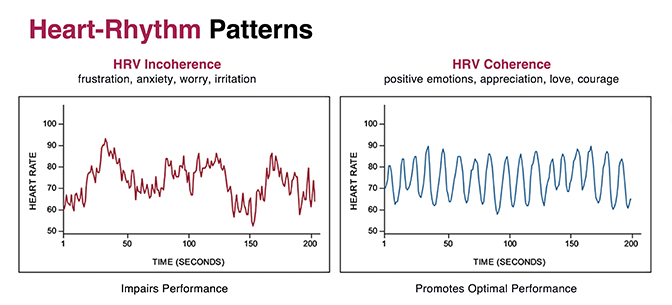
Study Looks at Coherence and Feeling States
Researchers at HeartMath Institute and elsewhere have undertaken numerous studies through the years that have demonstrated the ability of HeartMath® tools and technology to help people increase psychophysiological coherence. A recent one was a small study at a South African university in which people attempted to increase their positive feeling states and decrease their negative feeling states.
In a profile of the experience, one of the six participants who volunteered for the study, said: "Doing HeartMath makes me aware of my breathing and helps me to slow it down and breathe more deeply. It also helps me to focus and still my mind from fleeting thoughts and worries."
Breathing, of course, was an important aspect of the study because it is the first step of the technique participants used to self-regulate their feeling states. What HeartMath calls Heart-Focused Breathing along with the intentional activation or renewing of positive feelings are the primary elements of the Quick Coherence® Technique. (You will find the steps of this technique at the end of this article.)
Each Participant Used
Quick Coherence was used by each participant in conjunction with either HeartMath’s emWave2® or Inner Balance® coherence-building devices.
The participants, were instructed to complete and record their coherence levels for at least five sessions doing the technique while using one of the devices. They measured their coherence during four negative feeling states – angry, anxious, bored and sad – and four positive feeling states – contented, peaceful, happy and excited.
So, for example, before each session, participants would assess how much they were currently experiencing each of those feelings. After the session using the technique and one of the devices, they would do the same.

One of the participants had been struggling with several issues at the time of this study. "I started using HeartMath training as a way to help cope with severe anxiety and hyperventilating caused by anxiety. I found the first time I used (Quick Coherence) a bit difficult as I battled to calm my breathing and focus on a ‘happy and calm’ feeling. After a few attempts, I managed to acquire a sense of calm more easily. I found the HeartMath training a huge help in clearing my mind and calming myself, and I have used the breathing technique successfully in calming myself during panic attacks. … I also use it to clear my mind before I sleep." The study author notes that this Participant described significant improvement in severe anxiety, hyperventilation, panic attacks, emotional calmness, mental clarity and sleep.
When participants were introduced to this study it was explained that research had shown heart-rhythm coherence feedback training such as they would be undergoing has produced various physiological and psychological benefits. Physiologically, they were told, it had been shown the training could help to reduce blood pressure and that a common psychological benefit was improvement in positive emotions.
In fact, HeartMath has demonstrated coherence feedback training using HeartMath tools has provided a great many other benefits, not only for individuals in their personal lives, but also in clinical settings. Among the many areas in which improvements have been shown are:
- various types of trauma
- depression
- PTSD
- immune-system problems
- hypertension
- mental clarity and focus
- relationships
- academic performance
- behavior in children.
Another participant who used the Inner Balance, felt a desire to practice HeartMath tools anytime a feeling or situation caused overwhelm. "In general, there was one dominant emotion going into the practice, and I felt better about that emotion after the practice. Being plugged into the Inner Balance monitor, I also felt motivated to deal with the emotion, breathe through it, and manage it in this way."
And, another participant stated that there was a noticeable sense of calm and patience following each of the five sessions. This same participant was quoted as saying, "I have no doubt that continued practice will yield greater and longer-lasting control over my emotional state and therefore my overall well-being."
** Read the entire published study by clicking on Influence of HeartMath Quick Coherence Technique on psychophysiological coherence and feeling states.
The Quick Coherence Technique
You can increase your coherence in about a minute practicing these simple quick steps of this technique. It is especially useful when you begin feeling a draining emotion or negative emotional states such as frustration, irritation or anxiety.
Step 1: Heart-Focused breathing. Focus your attention in the area of the heart. Imagine your breath is flowing in and out of your heart or chest area, breathing a little slower and deeper than usual. Suggestion: Inhale 5 seconds, exhale 5 seconds (or whatever rhythm is comfortable).
Step 2: Activate a Positive Feeling. Make a sincere attempt to experience a regenerative feeling such as appreciation or care for someone or something in your life. Suggestion: Try to re-experience the feeling you have for someone you love, a pet, a special place, an accomplishment, etc., or focus on a feeling of calm or ease.
** Visit Quick Coherence for the complete steps and more information about this tool.
We would love to hear about your experiences using the Coherence Tools.

